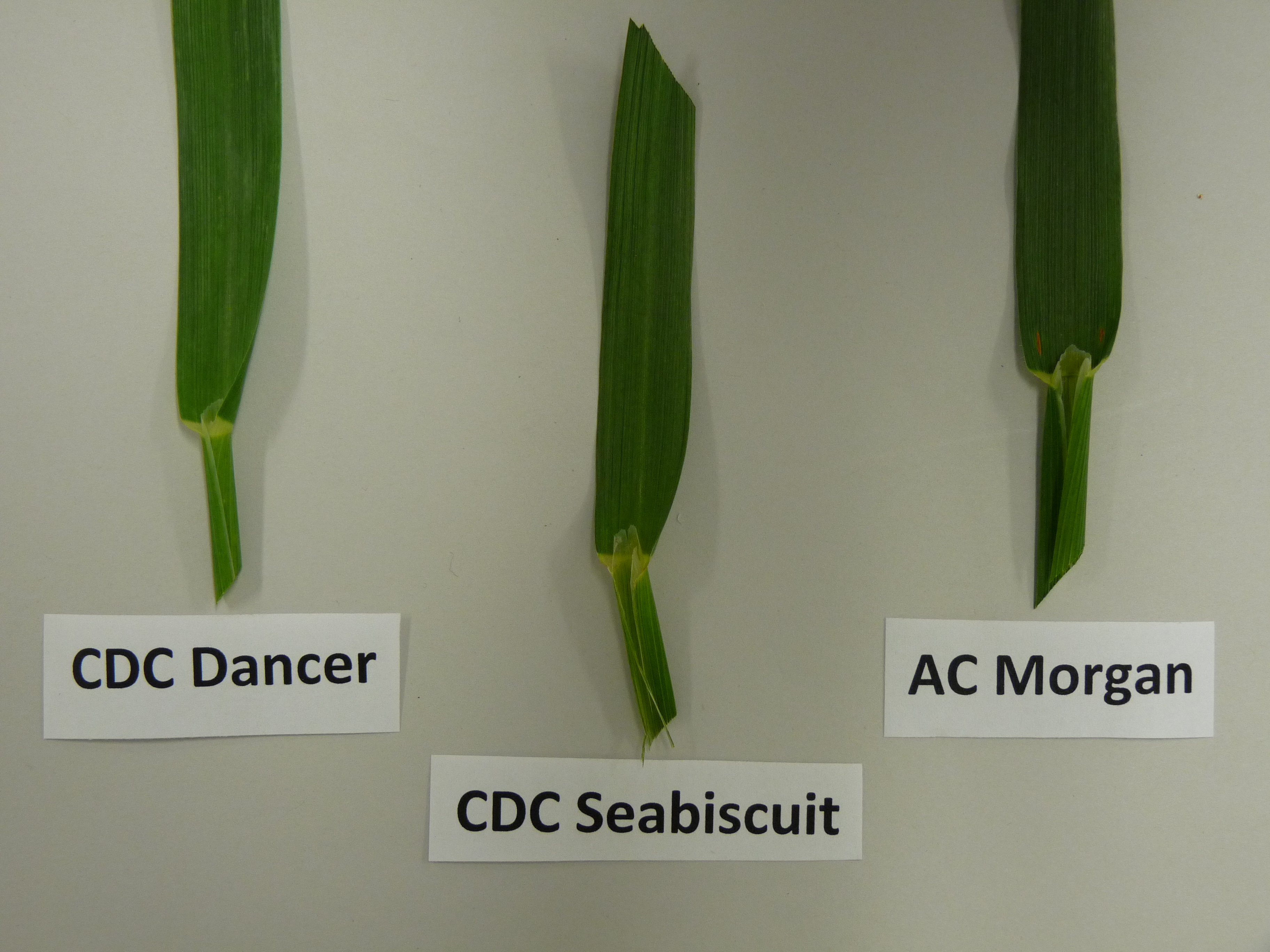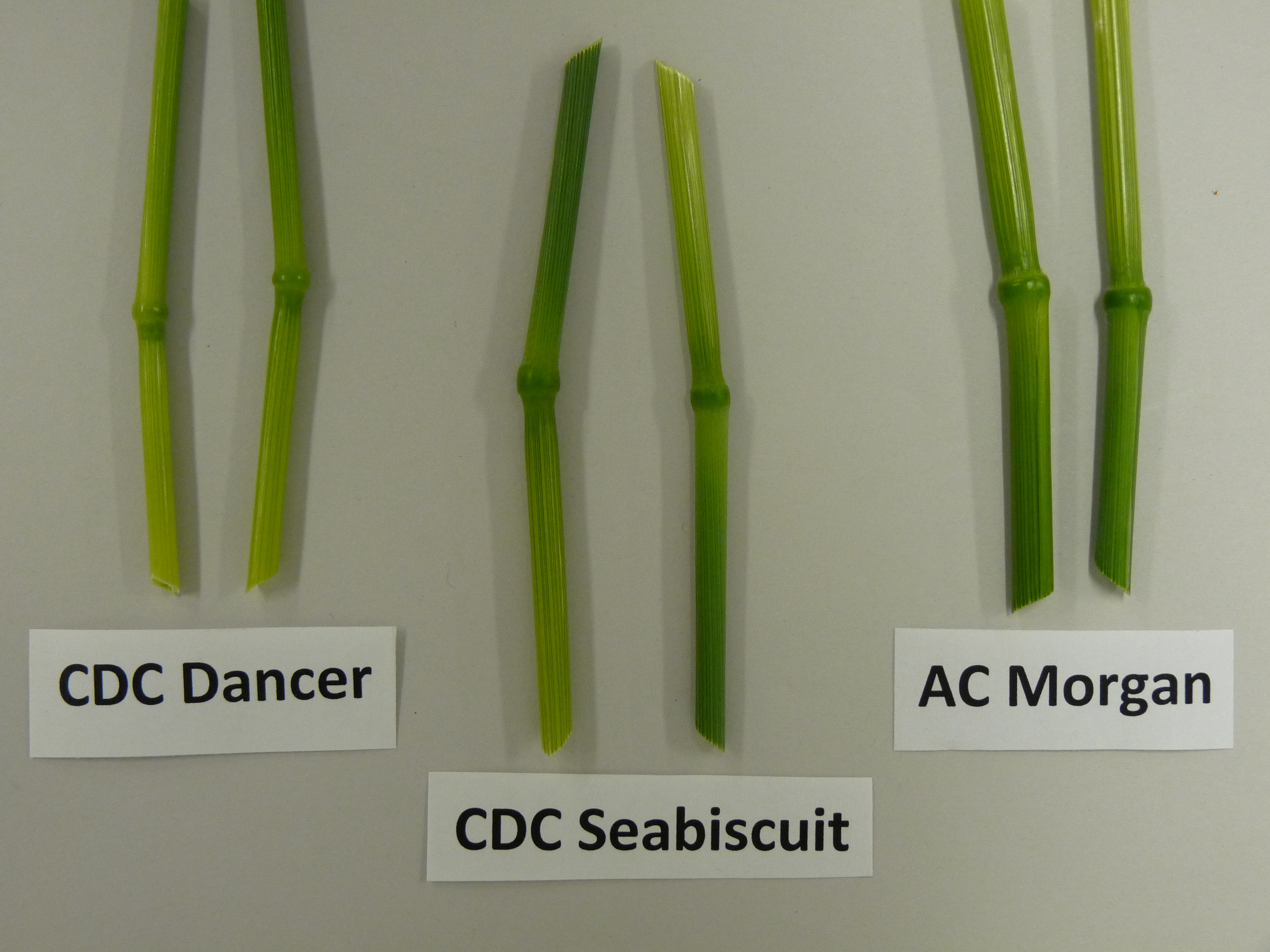CDC Seabiscuit
| Denomination: | 'CDC Seabiscuit' |
|---|---|
| Botanical Name: | Avena sativa |
| Applicant/Holder: |
University of Saskatchewan Crop Development Centre 4D36 Agriculture Building, 51 Campus Drive Saskatoon, Saskatchewan S7N 5A8 Canada |
| Breeder: |
Brian Rossnagel, University of Saskatchewan, Saskatoon, Saskatchewan |
| Application Date: | 2010-02-23 |
| Application Number: | 10-6851 |
| Grant of Rights Date: | 2012-02-16 |
| Certificate Number: | 4270 |
| Grant of Rights Termination Date: | 2030-02-16 |
Variety Description
Varieties used for comparison: 'CDC Dancer' and 'AC Morgan'
Summary: The density of pubescence on the lower leaf sheath of 'CDC Seabiscuit' is medium to dense while it is sparse to medium in 'CDC Dancer' and very dense in 'AC Morgan'. The pubescence on the leaf margins of 'CDC Seabiscuit' is medium while it is sparse in 'CDC Dancer'. The frequency of plants with recurved flag leaves is high in 'CDC Seabiscuit' while it is low to medium in 'CDC Dancer'. 'CDC Seabiscuit' heads later than the reference varieties. The plants of 'CDC Seabiscuit' are shorter in height than 'CDC Dancer'. The glaucosity of the lemma of 'CDC Seabiscuit' is strong while it is weak in 'AC Morgan'. 'CDC Seabiscuit' has a weak to medium tendency to be awned while it is absent to very weak in the reference varieties. There are basal hairs on the kernel of 'CDC Seabiscuit' while there is none in 'CDC Dancer'. 'CDC Seabiscuit' is susceptible to Crown rust (Puccinia coronata) while 'CDC Dancer' is moderately susceptible and 'AC Morgan' is highly susceptible. 'CDC Seabiscuit' is moderately resistant to moderately susceptible to Stem rust (Puccinia graminis f.sp. avena) while 'CDC Dancer' is resistant and 'AC Morgan' is highly susceptible. 'CDC Seabiscuit' is moderately resistant to Black loose smut (Ustilago avenae) while 'CDC Dancer' is resistant and 'AC Morgan' is susceptible. 'CDC Seabiscuit' is susceptible to Red Leaf (Barley yellow dwarf virus) while 'AC Morgan' is moderately susceptible.
Description:
SEEDLING (5-9 tiller stage): semi-erect to intermediate juvenile growth habit, medium to dense pubescence of lower leaf sheath and medium pubescence of lower blade
LEAF (at booting stage): medium green, medium pubescence of the margins, weak to medium intensity of glaucosity, high frequency of plants with recurved flag leaves, medium to very dense pubescence/hairiness above and below upper culm node
PANICLE (just after heading): equilateral/symmetrical orientation, medium to dense density
PANICLE BRANCHES: semi-erect to horizontal attitude, 30 to 45 degree angle between the rachis and dominant side branch
SPIKELET: medium to strong glaucosity of glumes, fracture separation of spikelet with semi-nodding to nodding attitude
RACHILLA: medium to long length between primary and secondary florets, medium length grooves, sparse pubescence
LEMMA: strong glaucosity, small to medium lateral overlap on palea, white to yellow at maturity, sparse to medium pubescence on the lateral and dorsal surfaces, weak to medium tendency to be awned
KERNEL (primary kernels from upper spikelets): hulled, short to medium length basal hairs, cream to yellow, two grains per spikelet, pointed medium-sized scutellum, medium to dense density of groat pubescence
AGRONOMIC CHARACTERISTICS: good lodging resistance, daylength sensitive
DISEASE RESISTANCE: susceptible to Crown Rust (Puccinia coronata) and Red Leaf (Barley yellow dwarf virus), moderately resistant to moderately susceptible to Stem rust (Puccina graminis f. sp. avenae) and moderately resistant to Black loose smut (Ustilago avenae)
Origin & Breeding History: 'CDC Seabiscuit' (experimental designation OT3036) was developed at the Crop Development Centre, University of Saskatchewan, Saskatoon, Saskatchewan using a pedigree breeding system. It arose from the cross 'OT396'/'HiFi' made in 2001. The F1 generation was grown as a bulk population in a nursery in New Zealand. The F2 population was grown as a bulk population in Saskatoon, Saskatchewan. During the winter of 2002 and 2003, the F3-F4 generations were grown as single seed derived lines and 'CDC Seabiscuit' was grown and selected in the field as a F5 hill plot in Saskatoon, Saskatchewan. It was then tested in CDC yield trials in 2005-2006, followed by testing in the Western Canadian Oat Cooperative trials during 2007 and 2008. Selection criteria for 'CDC Seabiscuit' included high grain yield combined with excellent milling yield, strong straw, good kernel quality, grain plumpness and disease resistance.
Tests & Trials: Tests and trials for 'CDC Seabiscuit' were conducted in Saskatoon, Saskatchewan during the summers of 2009 and 2010. Plots consisted of 5 rows with a row length of 3.7 metres and a row spacing of 20 cm. There were 2 replicates arranged in a RCB design.
Comparison tables for 'CDC Seabiscuit' with reference varieties 'CDC Dancer' and 'AC Morgan'
Number of days to heading (from planting to 50% of panicles fully emerged from boot)
| 'CDC Seabiscuit' | 'CDC Dancer' | 'AC Morgan' | |
|---|---|---|---|
| mean 2009 | 59 | 56 | 57 |
| mean 2010 | 65 | 63 | 61 |
Plant height (culm plus panicle)(cm)
| 'CDC Seabiscuit' | 'CDC Dancer' | 'AC Morgan' | |
|---|---|---|---|
| mean 2009 | 99.50 | 104.50 | 100.15 |
| standard deviation | 4.17 | 2.72 | 2.43 |
| mean 2010 | 98.25 | 103.35 | 99.15 |
| standard deviation | 3.35 | 4.07 | 4.72 |
Click on image for larger view

Oat: 'CDC Seabiscuit' (centre) with reference varieties 'CDC Dancer' (left) and 'AC Morgan' (right)
Click on image for larger view

Oat: 'CDC Seabiscuit' (centre) with reference varieties 'CDC Dancer' (left) and 'AC Morgan' (right)
- Date modified: